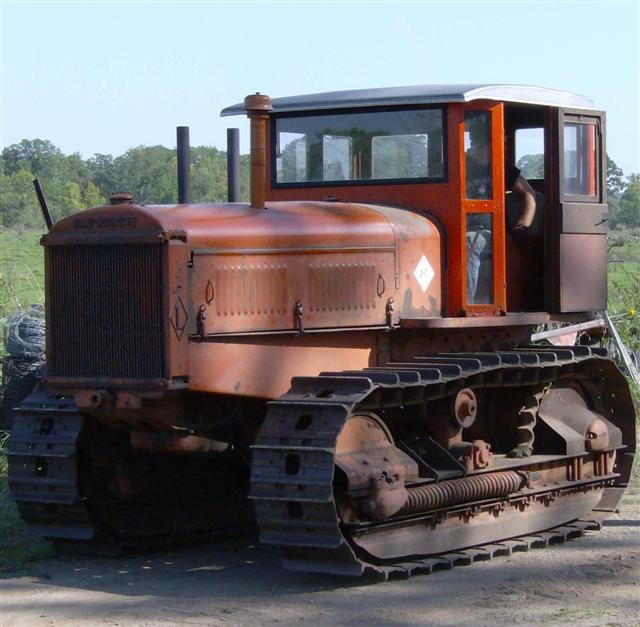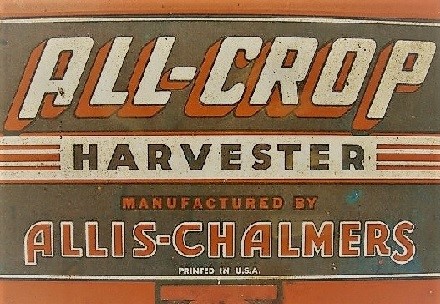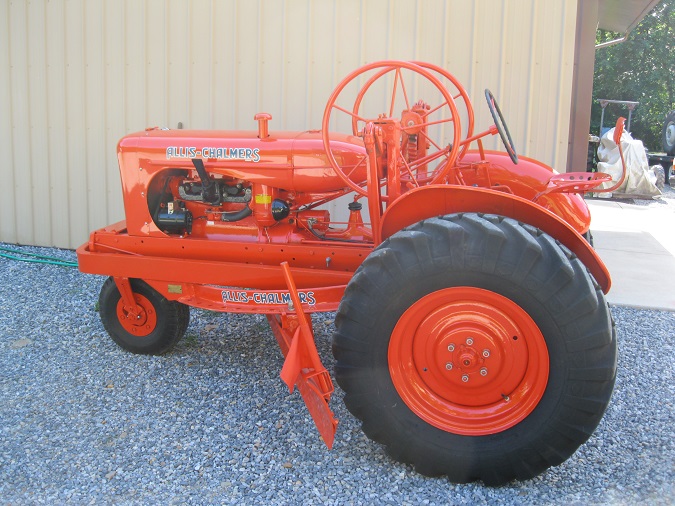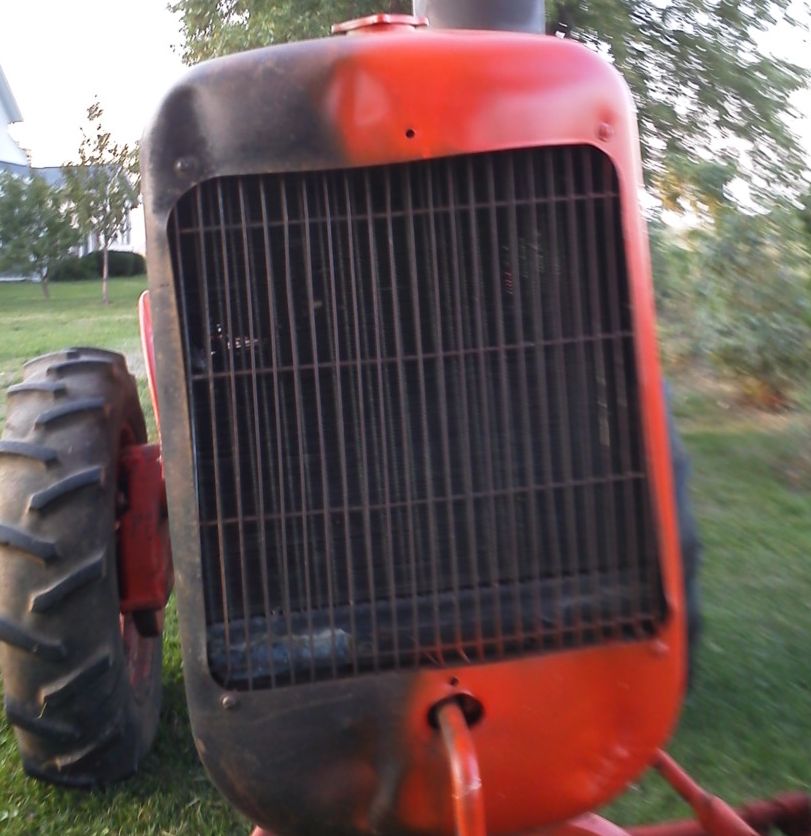| Author |
 Topic Search Topic Search  Topic Options Topic Options
|
Jacob (WI,ND) 
Orange Level


Joined: 11 Sep 2009
Location: Kenmare, ND
Points: 1249
|
 Post Options Post Options
 Thanks(0) Thanks(0)
 Quote Quote  Reply Reply
 Topic: Prest-O-Lite Gas Lighting Unit on Allis 20-35 Topic: Prest-O-Lite Gas Lighting Unit on Allis 20-35
Posted: 12 Jan 2019 at 4:18pm |
Hi all!I recently acquired this original piece of literature. It is from the Prest-O-Lite company. Covers the installation and parts of a Prest-O-Lite Gas Lighting Unit on an Allis 20-35 shortfender.https://photos.app.goo.gl/rrJCVSZ1bNYh8dPT8https://photos.app.goo.gl/LLeW9rXh2trKdGJBAThere is no date on the paper, but must be from 1928 or after based on the shortfender 20-35 in the pics.I had never seen this advertised before, so I had to have it. And I really have never seen one of these units in real life. Does anyone know if any of these still exist?Or is anyone familiar with these units?From what I have been able to look up so far (granted I have not spent a ton of time researching yet) it appears it was an acetylene tank that fueled gas lamps?This would be really cool to see in operation!
|
|
Jacob Swanson
1920 6-12; 1925,1926 20-35 longfenders; 1925,1926 15-25's; 1927,1929 20-35 shortfenders; C; B's; IB; WC's; WD; WD45
|
 |
|
Sponsored Links
|
|
 |
Pfouts Family Farm 
Bronze Level

Joined: 05 Dec 2018
Location: Hiram, Ohio
Points: 177
|
 Post Options Post Options
 Thanks(0) Thanks(0)
 Quote Quote  Reply Reply
 Posted: 12 Jan 2019 at 5:29pm Posted: 12 Jan 2019 at 5:29pm |
|
I have seen literature on a similar unit, though I don't think it was this exact literature, but I don't think I have actually seen a unit on a tractor.
|
 |
JC-WI 
Orange Level Access


Joined: 11 Sep 2009
Location: wisconsin
Points: 34430
|
 Post Options Post Options
 Thanks(0) Thanks(0)
 Quote Quote  Reply Reply
 Posted: 12 Jan 2019 at 6:28pm Posted: 12 Jan 2019 at 6:28pm |
Vigilink is effn the link you provided...
Maybe these might work...
|
|
He who says there is no evil has already deceived himself
The truth is the truth, sugar coated or not. Trawler II says, "Remember that."
|
 |
JohnCO 
Orange Level


Joined: 11 Sep 2009
Location: Niwot Colo
Points: 8992
|
 Post Options Post Options
 Thanks(0) Thanks(0)
 Quote Quote  Reply Reply
 Posted: 12 Jan 2019 at 6:47pm Posted: 12 Jan 2019 at 6:47pm |
|
1928 would have just about the end of the era for gas lights on vehicles, wonder how well they held up on bouncing tractors?
|
|
"If at first you don't succeed, get a bigger hammer"
Allis Express participant
|
 |
Jacob (WI,ND) 
Orange Level


Joined: 11 Sep 2009
Location: Kenmare, ND
Points: 1249
|
 Post Options Post Options
 Thanks(0) Thanks(0)
 Quote Quote  Reply Reply
 Posted: 12 Jan 2019 at 7:19pm Posted: 12 Jan 2019 at 7:19pm |
Mark- if you come across other literature, I'd love to see it.
JC- sorry about that, they work for me, thanks for putting up another link for people to see the pics.
John- good point, I hadn't thought about the fact that gas lights were on their way out at that point in time. Probably a very short lived idea on tractors? I wonder too how many were actually ever outfitted with such lights? Not being familiar with exactly how they work, I can't speak to how the rough ride would affect them. Anyone have any first hand knowledge of gas lights?
|
|
Jacob Swanson
1920 6-12; 1925,1926 20-35 longfenders; 1925,1926 15-25's; 1927,1929 20-35 shortfenders; C; B's; IB; WC's; WD; WD45
|
 |
JW in MO 
Orange Level


Joined: 16 Feb 2010
Location: South KC Area
Points: 2677
|
 Post Options Post Options
 Thanks(0) Thanks(0)
 Quote Quote  Reply Reply
 Posted: 12 Jan 2019 at 7:36pm Posted: 12 Jan 2019 at 7:36pm |
 JohnCO wrote: JohnCO wrote:
1928 would have just about the end of the era for gas lights on vehicles, wonder how well they held up on bouncing tractors?
|
Yes and acetylene is a VERY unstable gas, I would imagine the accidents would have been plenty. Transferring the stuff is very very dangerous, much like smoking and loading a black powder pistol.
|
|
Maximum use of available resources!
|
 |
CrestonM 
Orange Level


Joined: 08 Sep 2014
Location: Oklahoma
Points: 8459
|
 Post Options Post Options
 Thanks(0) Thanks(0)
 Quote Quote  Reply Reply
 Posted: 12 Jan 2019 at 8:03pm Posted: 12 Jan 2019 at 8:03pm |
A lot of rural houses had acetylene generators to provide gas for inside lighting. My great-grandparents' house had the generator working until the 1960s or so. They got electricity in '50, but kept the gas lights in case of a power failure.
I agree, it would be really neat to see one of those on a tractor!
|
 |
ecclap 
Silver Level

Joined: 24 Jan 2016
Location: Iowa
Points: 52
|
 Post Options Post Options
 Thanks(0) Thanks(0)
 Quote Quote  Reply Reply
 Posted: 27 Feb 2019 at 8:08pm Posted: 27 Feb 2019 at 8:08pm |
|
I have information on Prest-O-Lite lighting systems. These were still being made into the 1930's for many makes and models of tractors. There are a couple working systems on Deere tractors that I know of. Several years ago I dug for brochures and catalogs and I can help you put a system together.
|
 |
Jacob (WI,ND) 
Orange Level


Joined: 11 Sep 2009
Location: Kenmare, ND
Points: 1249
|
 Post Options Post Options
 Thanks(0) Thanks(0)
 Quote Quote  Reply Reply
 Posted: 27 Feb 2019 at 9:30pm Posted: 27 Feb 2019 at 9:30pm |
 ecclap wrote: ecclap wrote:
I have information on Prest-O-Lite lighting systems. These were still being made into the 1930's for many makes and models of tractors. There are a couple working systems on Deere tractors that I know of. Several years ago I dug for brochures and catalogs and I can help you put a system together. |
Very interesting Chris, I'd love to see and hear more about what information you have gathered.
|
|
Jacob Swanson
1920 6-12; 1925,1926 20-35 longfenders; 1925,1926 15-25's; 1927,1929 20-35 shortfenders; C; B's; IB; WC's; WD; WD45
|
 |
Lonn 
Orange Level


Joined: 16 Sep 2009
Location: Назарово,Russia
Points: 29817
|
 Post Options Post Options
 Thanks(0) Thanks(0)
 Quote Quote  Reply Reply
 Posted: 28 Feb 2019 at 6:16am Posted: 28 Feb 2019 at 6:16am |
|
Is figure 2 a pic of a long fender? It looks different than the rest.
|
|
-- --- .... .- -- -- .- -.. / .-- .- ... / .- / -- ..- .-. -.. . .-. .. -. --. / -.-. .... .. .-.. -.. / .-. .- .--. .. ... -
Wink
I am a Russian Bot
|
 |
Fred in Pa 
Orange Level


Joined: 13 Sep 2009
Location: Hanover Pa.
Points: 9210
|
 Post Options Post Options
 Thanks(0) Thanks(0)
 Quote Quote  Reply Reply
 Posted: 28 Feb 2019 at 10:09am Posted: 28 Feb 2019 at 10:09am |
|
NO it is NOT a Longfender
|
|
He who dies with the most toys is,
nonetheless ,still dead.
If all else fails ,Read all that is PRINTED.
|
 |
Fred in Pa 
Orange Level


Joined: 13 Sep 2009
Location: Hanover Pa.
Points: 9210
|
 Post Options Post Options
 Thanks(0) Thanks(0)
 Quote Quote  Reply Reply
 Posted: 28 Feb 2019 at 10:35am Posted: 28 Feb 2019 at 10:35am |
Here is one of the Longfender Tractors that I had .James Coons and his Dad came from Az. to get this one from me . He bought the G tractor after he got here ,He wanted to fill the trailer. LOL
|
|
He who dies with the most toys is,
nonetheless ,still dead.
If all else fails ,Read all that is PRINTED.
|
 |
DaveKamp 
Orange Level Access


Joined: 12 Apr 2010
Location: LeClaire, Ia
Points: 6108
|
 Post Options Post Options
 Thanks(0) Thanks(0)
 Quote Quote  Reply Reply
 Posted: 28 Feb 2019 at 7:37pm Posted: 28 Feb 2019 at 7:37pm |
So, the Prestolite tank is an Acetylene GENERATOR. There's a certain amount of danger in any circumstance, but it's all a matter of perspective. You could be killed by a glass of water... you could be burned by an exploding battery... or caught up in a PTO belt. If you understand how and why it works, perhaps you won't think it so scary.
Acetylene lights were really the first 'high intensity' lighting system. Acetylene gas, when passed through a proper nozzle, and behind a proper reflector, can lay down an awesome beam without a huge volume of fuel, and without generating rediculous amounts of waste heat... and it's NOT 'new' technology, it's very old, and very proven... and every bit as safe as oil lamps, but a whole lot cleaner burning. Aside from cars, trucks, and tractors, they also were used on bicycles and motorcycles, Steamships and steamboats used acetylene lamps for searchlights and navigation lights. Railroad locomotives- ditch lamps and main lamps... Caving and Mining: Miner's headlamps... Movies and stage- spotlights.
The acetylene generator is a simple gadget, works on a simple principle:
When you take a piece of Calcium Carbide (CaC2), and put a drop of water (H2O) on it, a chemical reaction occurs, and the primary byproduct is Calcium Hydroxide (CA(OH)2... and acetylene gas... C2H2.
2H2O + CaC2 -> Ca(OH)2 + C2H2
Low pressure. Very low pressure.
As long as you keep dripping water on the carbide, it will keep emitting gas, but in return, the carbide is consumed... it turns into Calcium Hydroxide... 'limewater'. Nothing dangerous there.
The acetylene generator doesn't 'hold' large quantities of acetylene... and it doesn't develop high pressure. Stop the drip, the gas stops.
The flame has to be set properly... there needs to be sufficient gas flow for the orfice to draw oxygen for a 'clean' white-hot burn. Turn up the lamp too far, the flame gets dim, because the reaction is not fast enough to supply the flame.
Shaking, vibrations... no effect on an acetylene system.
The acetylene generator usually contains a water chamber (for storage), and a carbide box (for placement of carbide), and a storage box for extra carbide. To operate the lamp, add water, and place a piece of carbide into the chamber. Open the drip valve, wait a minute or so, then open the lamp. Allow it to flow for a minute, to purge the air, then light, and adjust the lamp to full brightness. To increase output, increase drip rate of water, and adjust lamp accordingly. If you turn the water down too far, or the carbide runs out, the lamp will get weak, and eventually, extinguish.
To 'blow up', you need to disconnect the line to the lamp, put a ton of carbide in the bin, and flood the chamber, and wait for several hours for the area to accumulate gas. Then it'll go woof... for a moment.
|
|
Ten Amendments, Ten Commandments, and one Golden Rule solve most every problem. Citrus hand-cleaner with Pumice does the rest.
|
 |
Alberta Phil 
Orange Level


Joined: 13 Sep 2009
Location: Alberta, Canada
Points: 3953
|
 Post Options Post Options
 Thanks(0) Thanks(0)
 Quote Quote  Reply Reply
 Posted: 28 Feb 2019 at 8:33pm Posted: 28 Feb 2019 at 8:33pm |
Jacob, that Prestolite acetylene tank shown in your brochure is a special version of the small acetylene tanks that are still in common use. The difference is that the valve is placed off to one side on the head of the tank, rather than at the center like a standard welding tank.. It can then be used mounted in the horizontal position with the valve to the top without drawing off the liquid acetone that is in the tank into the lighting system. Acetylene gas will dissolve in the liquid acetone under pressure and then can be safely stored at pressures much greater than the critical 15 psi which is all free acetylene can be compressed to without a big 'Boom"!! This Prestolite system was very commonly used on cars and trucks up to about 1912 when electric headlights became more practical. I still see the occasional one of those tanks around still being used for acetylene welding.
Guys with pre 1912 antique cars are always on the lookout for one of these tanks.
As Dave pointed out, acetylene generators were also used, but they were mounted in an upright position.
|
 |
Jacob (WI,ND) 
Orange Level


Joined: 11 Sep 2009
Location: Kenmare, ND
Points: 1249
|
 Post Options Post Options
 Thanks(0) Thanks(0)
 Quote Quote  Reply Reply
 Posted: 28 Feb 2019 at 8:38pm Posted: 28 Feb 2019 at 8:38pm |
 DaveKamp wrote: DaveKamp wrote:
So, the Prestolite tank is an Acetylene GENERATOR. There's a certain amount of danger in any circumstance, but it's all a matter of perspective. You could be killed by a glass of water... you could be burned by an exploding battery... or caught up in a PTO belt. If you understand how and why it works, perhaps you won't think it so scary.
Acetylene lights were really the first 'high intensity' lighting system. Acetylene gas, when passed through a proper nozzle, and behind a proper reflector, can lay down an awesome beam without a huge volume of fuel, and without generating rediculous amounts of waste heat... and it's NOT 'new' technology, it's very old, and very proven... and every bit as safe as oil lamps, but a whole lot cleaner burning. Aside from cars, trucks, and tractors, they also were used on bicycles and motorcycles, Steamships and steamboats used acetylene lamps for searchlights and navigation lights. Railroad locomotives- ditch lamps and main lamps... Caving and Mining: Miner's headlamps... Movies and stage- spotlights.
The acetylene generator is a simple gadget, works on a simple principle:
When you take a piece of Calcium Carbide (CaC2), and put a drop of water (H2O) on it, a chemical reaction occurs, and the primary byproduct is Calcium Hydroxide (CA(OH)2... and acetylene gas... C2H2.
2H2O + CaC2 -> Ca(OH)2 + C2H2
Low pressure. Very low pressure.
As long as you keep dripping water on the carbide, it will keep emitting gas, but in return, the carbide is consumed... it turns into Calcium Hydroxide... 'limewater'. Nothing dangerous there.
The acetylene generator doesn't 'hold' large quantities of acetylene... and it doesn't develop high pressure. Stop the drip, the gas stops.
The flame has to be set properly... there needs to be sufficient gas flow for the orfice to draw oxygen for a 'clean' white-hot burn. Turn up the lamp too far, the flame gets dim, because the reaction is not fast enough to supply the flame.
Shaking, vibrations... no effect on an acetylene system.
The acetylene generator usually contains a water chamber (for storage), and a carbide box (for placement of carbide), and a storage box for extra carbide. To operate the lamp, add water, and place a piece of carbide into the chamber. Open the drip valve, wait a minute or so, then open the lamp. Allow it to flow for a minute, to purge the air, then light, and adjust the lamp to full brightness. To increase output, increase drip rate of water, and adjust lamp accordingly. If you turn the water down too far, or the carbide runs out, the lamp will get weak, and eventually, extinguish.
To 'blow up', you need to disconnect the line to the lamp, put a ton of carbide in the bin, and flood the chamber, and wait for several hours for the area to accumulate gas. Then it'll go woof... for a moment.
|
Dave, thank you for the great information! It is always nice when someone can explain things in a way that makes sense. But one thing that I'm not quite clear on here. I understand your explanation for acetylene generator lamps (add calcium carbide, drip water on it, burn the resulting gas to make light) but this particular add is not that type of lamp is it? Or am I not quite understanding everything? This add calls for just the one tank "style B prest-o-lite tank, with gas and key" and not a water tank, etc... like you describe. So does that make this system more like an acetylene torch? tun on the tank full of acetylene gas, light the lamp. No "making" the gas involved?
|
|
Jacob Swanson
1920 6-12; 1925,1926 20-35 longfenders; 1925,1926 15-25's; 1927,1929 20-35 shortfenders; C; B's; IB; WC's; WD; WD45
|
 |
Jacob (WI,ND) 
Orange Level


Joined: 11 Sep 2009
Location: Kenmare, ND
Points: 1249
|
 Post Options Post Options
 Thanks(0) Thanks(0)
 Quote Quote  Reply Reply
 Posted: 28 Feb 2019 at 8:42pm Posted: 28 Feb 2019 at 8:42pm |
 Alberta Phil wrote: Alberta Phil wrote:
Jacob, that Prestolite acetylene tank shown in your brochure is a special version of the small acetylene tanks that are still in common use. The difference is that the valve is placed off to one side on the head of the tank, rather than at the center like a standard welding tank.. It can then be used mounted in the horizontal position with the valve to the top without drawing off the liquid acetone that is in the tank into the lighting system. Acetylene gas will dissolve in the liquid acetone under pressure and then can be safely stored at pressures much greater than the critical 15 psi which is all free acetylene can be compressed to without a big 'Boom"!! This Prestolite system was very commonly used on cars and trucks up to about 1912 when electric headlights became more practical. I still see the occasional one of those tanks around still being used for acetylene welding.
Guys with pre 1912 antique cars are always on the lookout for one of these tanks.
As Dave pointed out, acetylene generators were also used, but they were mounted in an upright position.
|
Thanks Phil, you typed faster than I. I wonder how many of these ever got sold and put on 20-35's if this technology was on the way out by the 20's?
|
|
Jacob Swanson
1920 6-12; 1925,1926 20-35 longfenders; 1925,1926 15-25's; 1927,1929 20-35 shortfenders; C; B's; IB; WC's; WD; WD45
|
 |
DaveKamp 
Orange Level Access


Joined: 12 Apr 2010
Location: LeClaire, Ia
Points: 6108
|
 Post Options Post Options
 Thanks(0) Thanks(0)
 Quote Quote  Reply Reply
 Posted: 28 Feb 2019 at 9:53pm Posted: 28 Feb 2019 at 9:53pm |
Jake- Phil is right... I was looking at the doc with my phone (small image) and didn't catch that it was a "B" tank.
Prestolite packaged acetylene in small tanks for vehicle lighting... basically, motorcycles and vehicles, small soldering/brazing torches, etc... and you could exchange a tank at hardware stores, farm co-ops, and stuff like that... a convenience thing- a consumer didn't have to carry a dry box of carbide and water (good thing in winter, right?).
Modern acetylene is compressed, then saturated in acetone. This prevents the acetylene from being explosive if a tank, valve, or fitting becomes ruptured. To get an understanding... grab a plastic bottle of Dr. Pepper, and open the cap. IT foams up, and spills out, right? Now, open it SLOW. You'll see bubbles form, but they'll burst before coming to the cap. That's carbon dioxide, under pressure, and saturated in the soda syrup. When you relieve the pressure, the lack of pressure allows the CO2 to expand and leave the bottle... but it can only leave so fast.
That's what happens in a 'modern' tank... and it's because of that solution that you cannot lay an acetylene tank on it's side for use... the acetone will get ejected (in a foamy mess) into the valve, regulator, hose, and torch immediately.
The prestolite tank that you see there, is not for a dissolved solution... it's pressurized gas. it MAY be stuffed full of something fiberous (asbestos, etc) to limit it's exit in event of a problem.
I would not be surprised to find a fair amount fitted to tractors and used into the post WW2 era, simply because they worked.
Re. carbide gas generators... one of the 'big' companies that supplied carbide for lamps... was UNION CARBIDE. Later on, when acetylene lamps were retired in favor of electric lamps, Union Carbide started making... Flashlight batteries. ;-)
|
|
Ten Amendments, Ten Commandments, and one Golden Rule solve most every problem. Citrus hand-cleaner with Pumice does the rest.
|
 |
ecclap 
Silver Level

Joined: 24 Jan 2016
Location: Iowa
Points: 52
|
 Post Options Post Options
 Thanks(0) Thanks(0)
 Quote Quote  Reply Reply
 Posted: 28 Feb 2019 at 11:18pm Posted: 28 Feb 2019 at 11:18pm |
|
On another note, Union Carbide bought and owned Prest-O-Lite. Prest-O-Lite was the first company to successfully dissolve and store acetylene in pressurized tanks. They pioneered this process and industry.
|
 |









 Topic Options
Topic Options


 Post Options
Post Options Thanks(0)
Thanks(0)





 JohnCO wrote:
JohnCO wrote:



